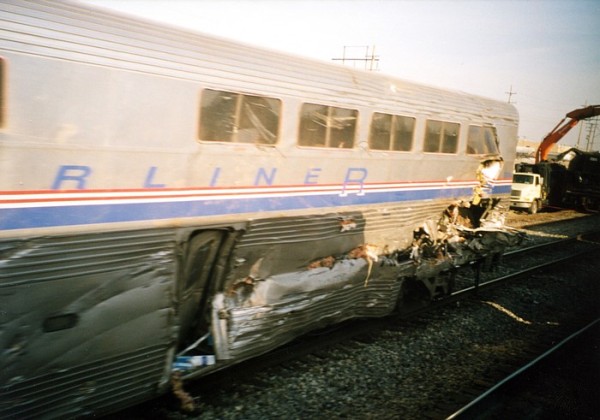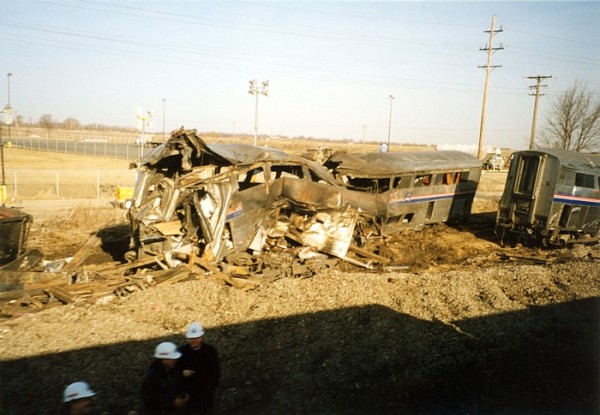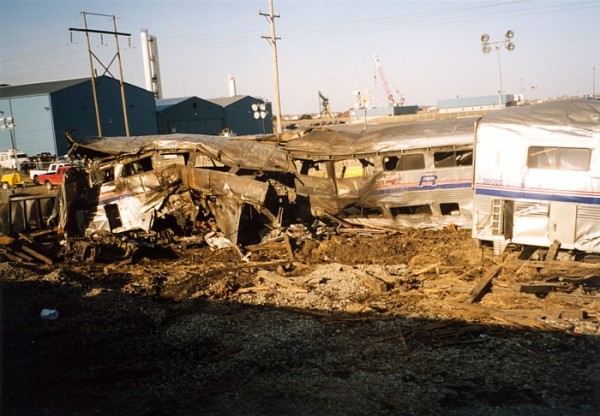The Wreck Of The City Of New Orleans At Bourbonnais
As a conductor on Amtrak, I am always aware of what can happen out on the railroad. While it is not something that you dwell on, it is always in the back of your mind that you are working in a job where it is a distinct possibility that someone could be seriously injured or killed while you are on duty.
Most of the time that involves someone getting hit by your train. In ten years, I have had six incidents which have resulted in three fatalities. Three were pedestrians, two of which were suicides, and three were vehicles. Fortunately, the drivers of all three vehicles escaped serious injury.
My regular run is on trains 58 and 59, The City of New Orleans, from Carbondale, Illinois, to Chicago. Since Amtrak’s inception, southbound train 59 has been in two major wrecks in the territory over which I work; Tonti, Illinois, in 1971 and the more widely known 1999 wreck at Bourbonnais, Illinois. Even though the Bourbonnais wreck happened a year and a half before I joined Amtrak, it was the first accident with which I had some involvement.
March 16, 1999, started like any other Monday morning. I was a college student at Southern Illinois University working on a degree in radio production while working a student job at WSIU, the local National Public Radio station. My job was as the board operator during Morning Edition, the morning NPR news show. Even though school was out for spring break, I was working just like any other day.
As usual I was up at 3am and at the radio station by 4:30. During my tenure at WSIU we had gone from a mostly tape based system to a computer based one, and I usually got in a little early to brew a pot of coffee and set the computer up to my liking. I would have all of my work organized for the entire shift before the station was even on the air.
At 4:50, I turned the transmitter on and at 5:00 Morning Edition was on the air. Almost immediately the news flooded the studio from the speakers on the wall: rescue workers are continuing to search for survivors following the wreck of an Amtrak train in Illinois. The mention of an Amtrak wreck in Illinois certainly got my attention, but it was when they said the wrecked train was called The City of New Orleans that my heart dropped.
The thought immediately hit me: “Are our guys okay?”
I had been hanging out around the Amtrak station since I was in grade school, and in the following years I had gotten to know a number of the engineers and conductors that worked the trains out of Carbondale. I also knew that some of those guys I had known for over a decade worked The City of New Orleans. Who was on that train? Were they okay? Could any of them be among the dead?
Time seemed to drag along as I waited for the Amtrak office in the station at Carbondale to open. I knew the woman who worked in the office, and if anyone would have an idea how they guys were doing, she would. Finally, a few minutes after 8:00, I made the call and was greeted with good news; while they were injured, our guys were basically okay.
I breathed a sigh of relief.
Three days later, I was on the northbound City of New Orleans. Since it was spring break, I had decided to make a railfan trip to Chicago on 58 and out on the BNSF Aurora line on Metra. It was uncertain exactly how this was going to work out, however, as the train had only been running as far north as Champaign since the wreck.
As we left Carbondale the Illinois Central said the line would be reopened by the time we got there, but Amtrak was still saying the train would terminate at Champaign and passengers would be bussed the rest of the way to Chicago. Nearly all the way to Champaign, there was no word as to what was going to happen.
Then as we were nearing the station at Champaign, the IC dispatcher called on the radio. He informed us the line was open and that we were indeed running all the way through to Chicago. The orders for our train had been printed at the Champaign yard office, and were to be found stuffed in a coupler knuckle nearby.
A little over an hour later we crept by the wrecked remains of the last southbound City of New Orleans. I took several photos of the aftermath of the wreck from a window in a room on the fireman’s side of the dorm car.
The first piece of equipment on the fireman’s side of the train was the crew dorm. It was sitting on the rails, having been moved onto a siding along the mainline. Both of the conductors had been in this car when the accident occurred.
The rear half of the dorm car’s lower level had sustained the most damage. Fortunately this part of the car had been empty at the time.
Laying in a pile of steel rebar were the burned remains of the second locomotive. The rebar had been scattered from the truck that caused the wreck, and it was this rebar that resulted in the wreck being as severe as it was. On hitting the truck, the rebar fell on the rail and the lead locomotive rode up on top of the rebar and derailed into a cut of freight cars loaded with slag from the nearby steel plant the truck had just left. The lead unit had been shoved off the right of way onto the opposite side of the track from where I was sitting.
When the train piled into the cut of standing freight cars, the sleeping car was twisted sideways and took the force of the following cars broadside. At the same time, the fuel tanks on the locomotives were ripped open and the spilled fuel ignited below it.
This is where the fatalities occurred, as eleven people were trapped in their rooms when the doors were jammed shut.
Immediately behind the sleeper was the dining car, which was serving dinner at the time of the accident. While the car sustained heavy damage, everyone inside survived.
That night saw the first departure of the southbound train since the wreck, and accordingly there were news cameramen seemingly everywhere. The ineptitude of the press was on full display when a cameraman approached a conductor with microphone outstretched and asked “are you the guy who says ‘all aboard?’” I will not repeat the reply, but suffice it to say it was not broadcast on the news.
I was in the lounge car as we passed the wreck scene that night. All of the equipment was still laying where it had been shoved off to the side; many of the cars covered by large blue tarps. All conversations ceased and the sound of the air hissing from the lounge’s ventilation system was the only sound as we passed by. As I looked around at the other passengers, I saw many eyes welling with tears as all were very well aware of exactly what they were looking at.
After passing the wreck, I headed back to the dorm car.
Postscript
The National Transportation Safety Board investigated the Bourbonnais wreck and placed the blame on the driver of the truck, finding that he had driven around the gates in an attempt to beat the train. The trucker, who had a less than stellar driving record and who was driving on a temporary license, was cleared of wrongdoing by the Illinois State Police.
The trucker who caused the death of eleven people avoided prison for a time, but eventually did serve a federal sentence for falsifying his logbook.
One important thing came of the wreck for Amtrak passengers: it was as a result of this wreck that every sleeping car room now has an emergency exit window.
———-
Photography and Story Copyright 2010 – Mary Rae McPherson








Once again a job well done Mary, Thank You T.J.
I remember the crossing as that is where we parked long trains if we had to pickup cars at KKK yard when going south. Thanks Mary….
Didn’t this incident also lead to discovery of the scandal in Gov. George Ryan’s office? Something about truck licenses being bought. And didn’t this guy have one of them?
That is what I have heard, but not having any actual documentation I decided to leave that out of the article.
Mary
Yes, This incident was one of the many that added to the investigation of the driver’s license scandal for the Secretary of State. The main incident that started the investigation (I believe) was when a truck driver who illegally obtained his license (by bribing an Examiner) lost a portion of a mudflap-bracket which then bounced off the roadway and through the windshield of a minivan, killing the family in it. The driver had not properly done a pre-trip inspection because he didn’t know the rule about that (citing the bribery for a license and failure to properly pass all 3 exams for a CDL license). The 3 exams for Illinois are: Written test via computer, Pre-trip test (vehicle inspection), on-site driving test (turning, backing, etc) and the Road test. Following the many accidents that occurred during those years, the Secretary of State reviewed and later required the retesting of many CDL drivers suspected of falsifying their applications, failing tests, and/or bribing state-examiners.
The trucker should have gone to jail for manslaughter considering he killed 11 people and injured 122. It was his fault that this train wrecked.
Where’s the “upvote” button?
However, I must add that my outrage at the police indifference is due not so much to the number of casualties as to the deliberate, egregious nature of the truck driver’s actions. His negligence was *willful*.
I contrast that with the stubborn prosecution of Amtrak engineer Brandon Bostian for the May 12, 2015 derailment at Frankford Junction in Philadelphia. That disaster was caused by “loss of situational awareness”, a common human failing well known by any driver who has ever absent-mindedly missed a turn or exit on a familiar route. If there was willful negligence in that case, it was Amtrak’s for leaving part of the busiest rail route in the country without even 1960’s-type cab signaling. A squawk from the control unit would have snapped Bostian out of his funk. This prosecution was pushed, against some judicial and political opposition, by the Pennsylvania State Prosecutor, apparently one of the too-many prosecutors who don’t seem to recognize the difference between justice and vengeance. Fortunately the jury had better sense and quickly acquitted Bostian.
I work in the raolroad industry, and have been conducting rail accident investigations for quite some time now. Primarily, my goal is to study various accidents, and to develop ideas and corrective actions to prevent re-occurrences. I look at various promary and secondary causal factors, including human error, technological failures, etc.
Throughout my own investigations, and studies that I’ve conducted, I get personally sick with the stupidity, arrogance, and ignorance of vehicle drivers who ignore railroad crossing gate barriers and warning lights. This is prevalent, not only in heavy railroading (freight, commuter, Amtrak), but in transit as well (light rail, trolley and streetcar operations).
This guy tried to cross in front of a passenger train with a load of steel in the trailer. I find this unconscionable. Now, just yesterday, on April 20, 2011, another tractor trailer was incolved in a collision with an Amtrak train in Louisiana. There have been numerous fatal accidents at crossings involving cars, trucks and buses since this accident in Illinois in 1999. Hopefully, with appropriate funding many railroad crossings can be eliminated. However, with the thousands of railroad miles in this country, it is not feasible or possible.
A LITTLE COMMON SENSE would go a long way here. I do agree with one of the respondents here, the truck driver deserved prison. Well, anyway, he has to live with 11 fatalities ( a number of them little girls) for the rest of his life.
Hello,
I just heard of this wreck, but have been intrigued by it. My Automotive Technology teacher first told me about it, and this is what he said:
“Have you heard of “The City of New Orleans?” Well, when I was trucking steel about 10 years ago, I was living where I grew up; about 30 miles south of Kankakee, Illinois. I was trucking 60ft re-bar with a buddy of mine. Being 60ft, it stuck out over the end of the flatbed. He was trucking, and came to an Amtrak line where “The City of New Orleans” tracks along. He came to an intersection, and, since the crossbar was not down (at the time), he decided to go across. However, he did not look down the tracks to see if there was a train. As he was passing over the tracks, he looked to the side and saw the train. He tried to get across, but was not able to all the way. The train hit the trailer, derailed, and part of it caught on fire because of the gas tanks. Several people died because of it. It turns out, when he was investigated, his logbook was wrong and went to jail for like 10 years because of it.”
I found this extremely interesting, and very sad. I would have to agree that it is quite idiotic that he did not look down the railroad tracks. I ended up hearing about this because I made a statement that I do not understand WHY buses have to stop at railroad tracks, even with cross-lights, barriers, etc. But, now, I definitely have a different take on this.
As a former truck and school bus driver, it was WELL drilled into us that there is never, ever any reason to drive around a lowered gate (unless a flagman directed it). So, it just amazes me, even after 43 years of living, why people continue to try and beat trains. I lived in Chicago when the woman bus driver drove around the lowered gates and caused the death of several high-school kids and then hearing about this wreck, it just saddens me to keep learning of peoples’ stupidity at thinking that the impact of several hundred tons of fast moving Amtrak won’t be a problem… Simply moronic thinking on the car, bus, or truck drivers that think this. Peace be to those that pass on because of the poor decisions of others’ thinking.